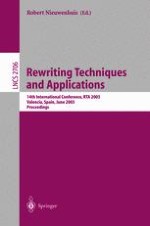2003 | Buch
Rewriting Techniques and Applications
14th International Conference, RTA 2003 Valencia, Spain, June 9–11, 2003 Proceedings
herausgegeben von: Robert Nieuwenhuis
Verlag: Springer Berlin Heidelberg
Buchreihe : Lecture Notes in Computer Science
Enthalten in: Professional Book Archive
